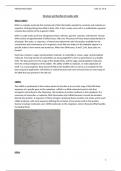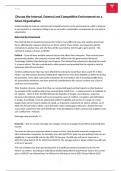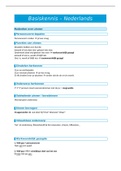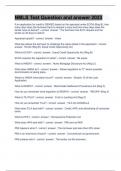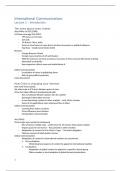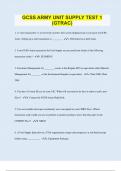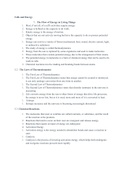Structure and function of nucleic acids
What is DNA?
DNA is a complex molecule that contains all of the information needed to construct and maintain an
organism. All living things have DNA in their cells. In fact, nearly every cell in a multicellular organism
contains the entirety of the organism's DNA.
DNA is a code made up of four nitrogenous bases: adenine, guanine, cytosine, and thymine. Human
DNA consists of approximately 3 billion bases, with over 99 percent of those bases being identical in
all people. The order, or sequence, of these bases determines the information available for the
construction and maintenance of an organism, much like how letters of the alphabet appear in a
specific order to form words and sentences. When two DNA bases, A and T, join, base pairs are
formed.
Each base contains a sugar and phosphate molecule. A nucleotide is a base, sugar, and phosphate
molecule. Two long strands of nucleotides are strung together to form a spiral known as a double
helix. The base pairs form the rungs of the double helix, and the sugar and phosphate molecules
form the vertical sidepieces of the ladder. The ability of DNA to replicate, or make duplicates of
itself, is a crucial property. Each strand of DNA in the double helix can serve as a template for the
base sequence duplication. Cell division is critical because each new cell must have an exact copy of
the DNA that was present in the old cell.
mRNA:
The mRNA is synthesised in the nucleus where its function is to carry the copy of the DNA base
sequence of a specific gene to the cytoplasm. mRNA is an RNA molecule found in cells that
transports instructions to the ribosomes, the locations of protein synthesis in the cytoplasm. It is
necessary to transcribe, or replicate, DNA information into mRNA because it cannot be decoded
directly into protein. A sequence of three nitrogen-containing bases encodes one amino acid in each
mRNA molecule, with each sequence defining the inclusion of one amino acid in that protein.
Nuclear envelope molecules carry mRNA molecules to the cytoplasm, where ribosomal RNA handles
translating them.
rRNA:
1
,Mohammed Salam Unit 11: LA A
The ribosome is formed by the fusion of ribosomal RNAs and proteins in the cytoplasm. The
ribosome is a nucleoprotein complex that binds mRNA and synthesises proteins. Based on their
length and position, these rRNA stem-loops can form species-specific three-dimensional structural
arrangements depending on the length and position of the base pairs within such sequences. It is
possible for rRNA to form strong and specialized interactions with ribosomal proteins to form
ribosomal subunits due to its varied configurations. They can form chemical interactions with their
corresponding RNA sections, including stacking interactions, since they have basic rather than acidic
and aromatic residues (such as phenylalanine, tyrosine, and tryptophan). A sugar-phosphate
backbone of rRNA can be cross-linked by ribosomal proteins via basic residues (lysine and arginine).
tRNA:
As amino acids are transferred from the mRNA sequence to the developing polypeptide chain at the
ribosome by transfer RNA, a short RNA chain of 80 nucleotides is formed. A tRNA is a ribonucleic
acid and can form hydrogen bonds with mRNA in addition to creating ester bonds with amino acids
through translation, bringing mRNA and amino acids physically together. As each tRNA can pair with
a three-nucleotide stretch of mRNA in a complementary and antiparallel fashion, they base pair with
mRNA in complementary and antiparallel fashion. Codons and anticodons are three-nucleotide
sequences found on mRNA, and they correspond to the three-nucleotide sequences on tRNA.
Translation is made more specific by pairing codons with anticodons.
The anticodon of a transfer RNA and its terminal hydroxyl group, which can form an ester bond with
an amino acid, make up the two most important parts of a tRNA, which are codified by several
genes. TRNAs' specificity and efficiency are further enhanced by their D-arm and T-arm structural
features. In light of the chemical similarities between many amino acids, only 1 out of 10,000 amino
acids has an incorrect tRNA attachment. In the structure of transfer RNAs, sugar-phosphate
backbones are like those of other nucleic acids, and the orientation of the ribose sugar determines
the direction in which the molecule will travel. In tRNA, the fifth carbon atom of ribose is connected
to a reactive phosphate group, while the third carbon atom is coupled to a free hydroxyl group.
These phosphodiester linkages produce the 5' and 3' ends of the RNA because all the other
phosphate and hydroxyl groups are involved.
2
, Mohammed Salam Unit 11: LA A
SiRNA:
During gene expression, small interfering ribonucleic acids (siRNA) inhibit gene expression, thus
silencing genes. An RNA interference mechanism or siRNA knockdown is the complete process of
gene silencing using siRNA. In contrast to other types of RNA, siRNA consists of a single-stranded
polynucleotide chain unlike the longer polynucleotide chains found in other RNAs. Inhibition of
protein translation by siRNA occurs through its double-stranded, 20 to 25 nucleotide length, and
short nature. The siRNA is exogenous, and it is derived from ribosomes. In addition to these features,
the presence of the 3' OH dinucleotide overhang sets siRNA apart from other RNAs. The SiRNA is
located in the cytoplasm.
3

